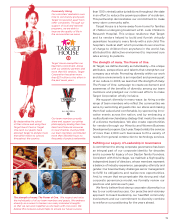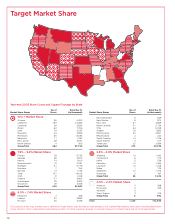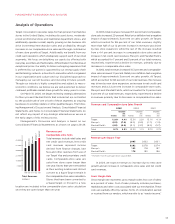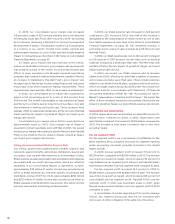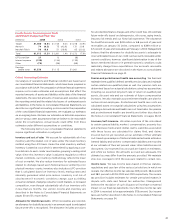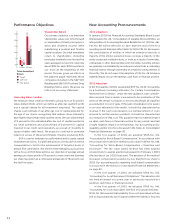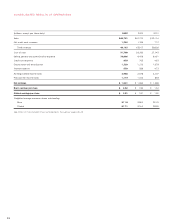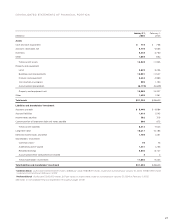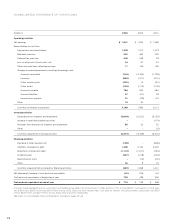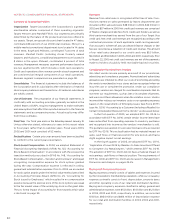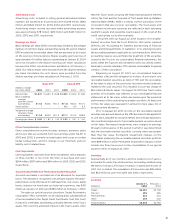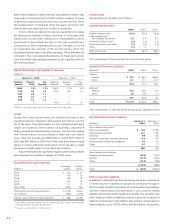Target 2003 Annual Report Download - page 26
Download and view the complete annual report
Please find page 26 of the 2003 Target annual report below. You can navigate through the pages in the report by either clicking on the pages listed below, or by using the keyword search tool below to find specific information within the annual report.
24
Performance Objectives
Shareholder Return
Our primary objective is to maximize
shareholder value over time through
a combination of share price appreci-
ation and dividend income while
maintaining a prudent and flexible
capital structure. Our total annualized
return to shareholders (including
reinvested dividends) over the last five
years averaged 4.2 percent, returning
about $123 for each $100 invested in
our stock at the beginning of this
period. The peer group we refer to in
the adjacent graph represents those
companies included in the S&P 500
Retailing and S&P 500 Food and Drug
Retailing Indices, and is the group we
refer to in our proxy statement.
Measuring Value Creation
We measure value creation internally using a form of Economic
Value Added (EVA), which we define as after-tax segment profit
less a capital charge for all investment employed. The capital
charge is an estimate of our after-tax cost of capital adjusted for
the age of our stores, recognizing that mature stores inherently
have higher returns than newly opened stores. We use a benchmark
of 9 percent for the estimated after-tax cost of capital invested in
our retail operations and a benchmark of 5 percent for capital
invested in our credit card operations, as a result of its ability to
support higher debt levels. We expect to continue to generate
returns in excess of these benchmarks, thereby producing EVA.
EVA is used to evaluate our performance and to guide capital
investment decisions. A significant portion of executive incentive
compensation is tied to the achievement of targeted levels of
annual EVA generation. We believe that managing our business
with a focus on EVA helps achieve our objective of average annual
earnings per share growth of 15 percent or more over time. Earnings
per share has grown at a compound annual rate of 15 percent over
the last five years.
New Accounting Pronouncements
2004 Adoptions
In January 2003, the Financial Accounting Standards Board issued
Interpretation No. 46, “Consolidation of Variable Interest Entities, an
interpretation of Accounting Research Bulletin No. 51” (FIN No. 46).
FIN No. 46 will be effective no later than the end of the first
reporting period that ends after March 15, 2004. FIN No. 46 requires
the consolidation of entities in which an enterprise absorbs a
majority of the entity’s expected losses, receives a majority of the
entity’s expected residual returns, or both, as a result of ownership,
contractual or other financial interest in the entity. Currently, entities
are generally consolidated by an enterprise when it has a controlling
financial interest through ownership of a majority voting interest in
the entity. We do not expect the adoption of FIN No. 46 to have a
material impact on our net earnings, cash flows or financial position.
2003 Adoptions
In the first quarter of 2003, we adopted EITF No. 02-16, “Accounting
by a Customer (Including a Reseller) for Certain Consideration
Received from a Vendor.” Under the new guidance, cash consider-
ation received from a vendor is presumed to be a reduction of the
prices of the vendor’s products or services and should be classified
as a reduction in cost of sales. If the cash consideration is for assets
or services delivered to the vendor, it should be characterized as
revenue. If the cash consideration is a reimbursement of costs
incurred to sell the vendor’s products, it should be characterized
as a reduction of that cost. This guidance had no material impact
on sales, cash flows or financial position for any period, and had
a slight negative impact on net earnings. Our accounting policy
regarding vendor income is discussed in the Notes to Consolidated
Financial Statements on page 30.
In the first quarter of 2003, we adopted SFAS No. 123,
“Accounting for Stock-Based Compensation,” in accordance with
the prospective transition method prescribed in SFAS No. 148,
“Accounting for Stock-Based Compensation — Transition and
Disclosure.” The fair value based method has been applied
prospectively to awards granted subsequent to February 1, 2003
(the last day of our 2002 fiscal year). The adoption of this method
increased compensation expense by less than $.01 per share in
2003. Our accounting policy regarding stock-based compensation
is discussed in the Notes to Consolidated Financial Statements
on page 30.
In the first quarter of 2003, we adopted SFAS No. 143,
“Accounting for Asset Retirement Obligations.” The adoption did
not have an impact on current year or previously reported net
earnings, cash flows or financial position.
In the first quarter of 2003, we adopted SFAS No. 146,
“Accounting for Costs Associated with Exit or Disposal Activities.”
SFAS No. 146 requires that a liability for a cost associated with an
exit or disposal activity be recognized when the liability is incurred
5 Year 10 Year
4%
–1%
2%
23%
11%
25
15
20
10
5
0
13%
Total Annualized
Return
Target
S&P 500
Peer group



